Probabilistic Analysis of Drought Spatiotemporal Characteristics in the Beijing-Tianjin-Hebei Metropolitan Area in China
Abstract
:1. Introduction
2. Study Area and Database
| Station Name | Longitude (E) | Latitude (N) | Elevation (m) | Mean (mm) | Standard Deviation (mm) |
|---|---|---|---|---|---|
| Beijing | 116.47 | 39.80 | 31.30 | 536.32 | 172.07 |
| Zhangbei | 114.70 | 41.15 | 1393.30 | 386.94 | 68.47 |
| Weixian | 114.57 | 39.83 | 909.50 | 398.88 | 88.09 |
| Shijiazhuang | 114.42 | 38.03 | 81.00 | 525.89 | 172.28 |
| Xingtai | 114.50 | 37.07 | 77.30 | 515.19 | 176.86 |
| Fengning | 116.63 | 41.22 | 661.20 | 458.04 | 89.55 |
| Weichang | 117.75 | 41.93 | 842.80 | 433.49 | 88.21 |
| Zhangjiakou | 114.88 | 40.78 | 724.20 | 399.00 | 91.85 |
| Huailai | 115.50 | 40.40 | 536.80 | 378.98 | 80.58 |
| Chengde | 117.95 | 40.98 | 385.90 | 518.28 | 108.71 |
| Zunhua | 117.95 | 40.20 | 54.90 | 711.88 | 201.17 |
| Qinglong | 118.95 | 40.40 | 227.50 | 691.79 | 190.63 |
| Qinhuangdao | 119.52 | 39.85 | 2.40 | 634.01 | 179.22 |
| Bazhou | 116.38 | 39.12 | 9.00 | 511.18 | 184.55 |
| Tangshan | 118.15 | 39.67 | 27.80 | 605.37 | 160.43 |
| Laoting | 118.88 | 39.43 | 10.50 | 600.22 | 176.73 |
| Baoding | 115.52 | 38.85 | 17.20 | 517.57 | 195.07 |
| Raoyang | 115.73 | 38.23 | 19.00 | 519.99 | 153.49 |
| Cangzhou | 116.83 | 38.33 | 9.60 | 610.09 | 194.76 |
| Huanghua | 117.35 | 38.37 | 6.60 | 589.70 | 196.37 |
| Nangong | 115.38 | 37.37 | 27.40 | 478.54 | 142.07 |
| Anyang | 114.40 | 36.05 | 62.90 | 561.60 | 169.20 |
| Jianpingxian | 119.70 | 41.38 | 422.00 | 459.86 | 107.01 |
| Huade | 114.00 | 41.90 | 1482.70 | 307.79 | 66.02 |
| Duolun | 116.47 | 42.18 | 1245.40 | 375.24 | 70.05 |
| Dezhou | 116.32 | 37.43 | 21.20 | 567.40 | 182.87 |
| Huimin | 117.53 | 37.48 | 11.70 | 572.64 | 172.16 |
| Shenxian | 115.67 | 36.23 | 37.80 | 539.63 | 158.65 |
| Datong | 113.33 | 40.10 | 1067.20 | 370.24 | 84.31 |
| Wutaishan | 113.52 | 38.95 | 2208.30 | 748.29 | 183.55 |
| Yangquan | 113.55 | 37.85 | 741.90 | 541.07 | 148.24 |
| Tianjin | 117.07 | 39.08 | 2.50 | 536.45 | 147.41 |
| Tanggu | 117.72 | 39.05 | 4.80 | 575.59 | 183.33 |

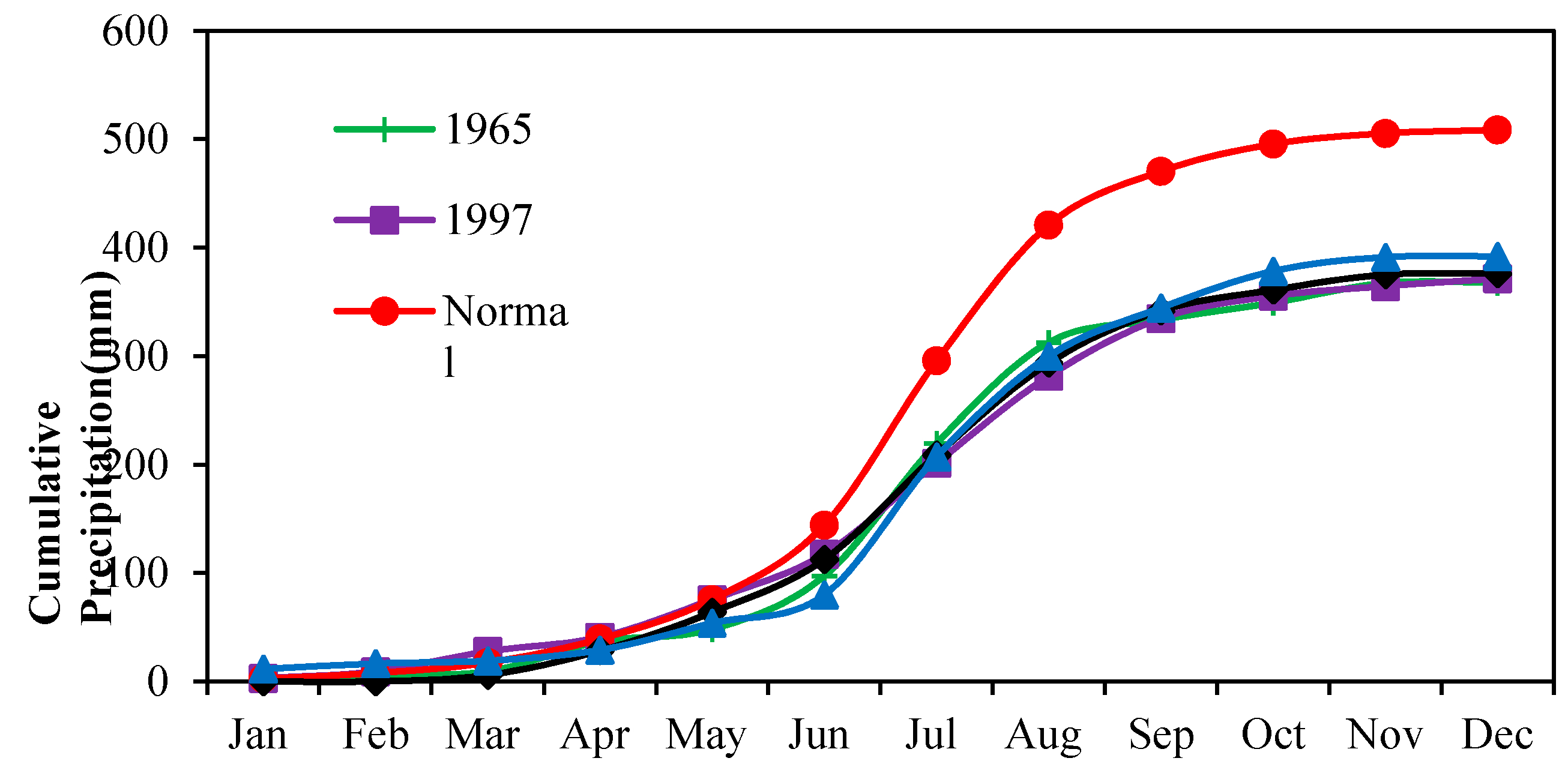
3. Materials and Methods
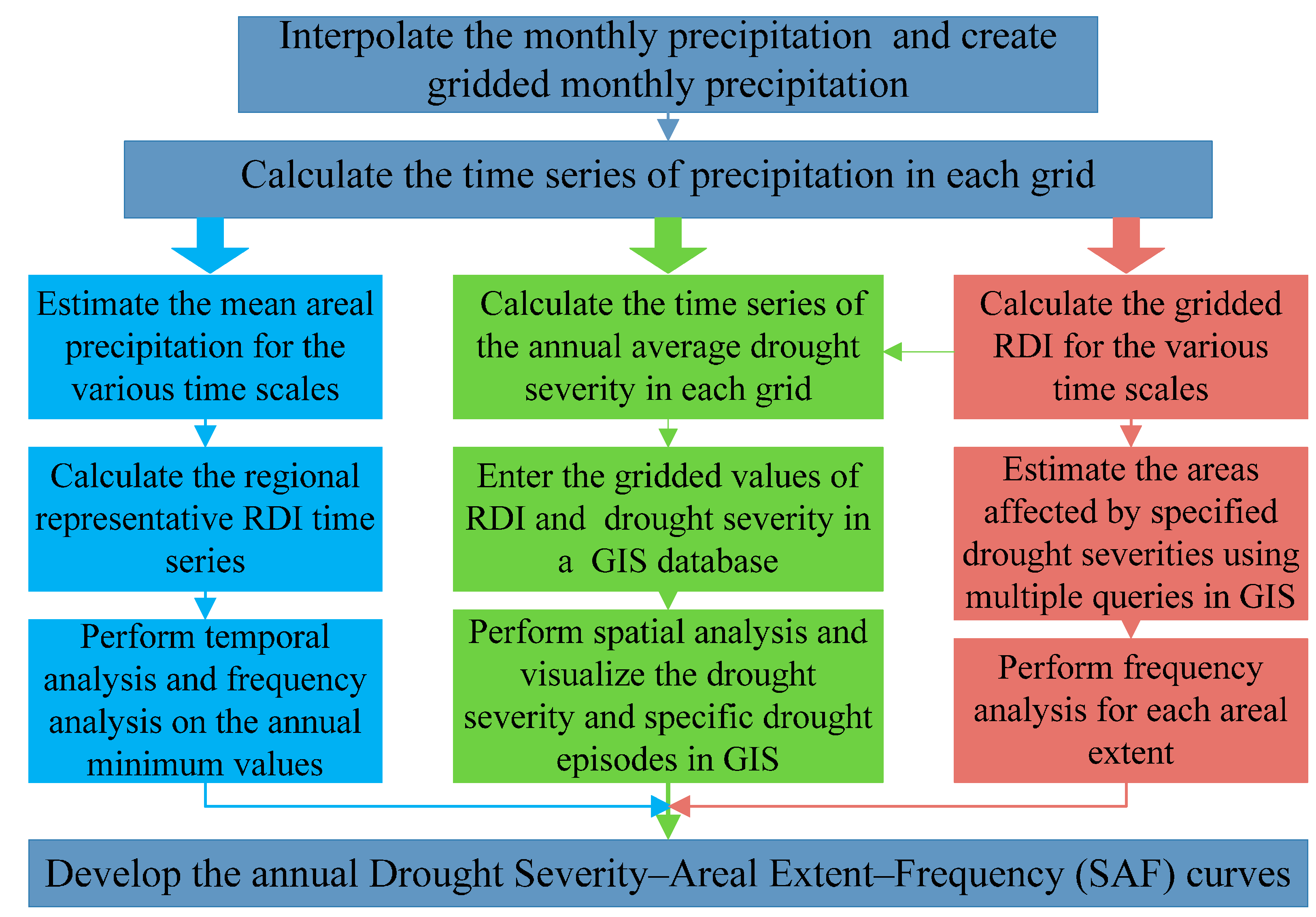
3.1. Spatial Interpolation of Precipitation
3.2. Drought Identification
| Drought Class | RDI Value |
|---|---|
| Extremely wet | RDI ≥ 2.0 |
| Very wet | 1.5 ≤ RDI < 2.0 |
| Moderately wet | 1.0 ≤ RDI < 1.5 |
| Near normal | −1.0 ≤ RDI < 1.0 |
| Moderate drought | −1.5 ≤ RDI < −1.0 |
| Severe drought | −2.0 ≤ RDI < −1.5 |
| Extreme drought | RDI < −2.0 |
3.3. Temporal and Spatial Analysis of Droughts in the BTHMA
4. Results and Discussion
4.1. Temporal Characteristics of Droughts in BTHMA
| Month | 3-Month RDI/% | 6-Month RDI/% | 12-Month RDI/% |
|---|---|---|---|
| January | 21.5 | 19.8 | 12.8 |
| February | 16.1 | 19.8 | 16.1 |
| March | 12.5 | 12.5 | 21.1 |
| April | 9.1 | 9.1 | 9.2 |
| May | 3.2 | 5.8 | 5.2 |
| June | 3.2 | 3.1 | 3.1 |
| July | 6.3 | 0.0 | 3.1 |
| August | 6.3 | 3.1 | 3.0 |
| September | 3.2 | 5.8 | 5.2 |
| October | 6.3 | 6.1 | 6.3 |
| November | 9.1 | 5.8 | 6.3 |
| December | 3.2 | 9.1 | 9.8 |
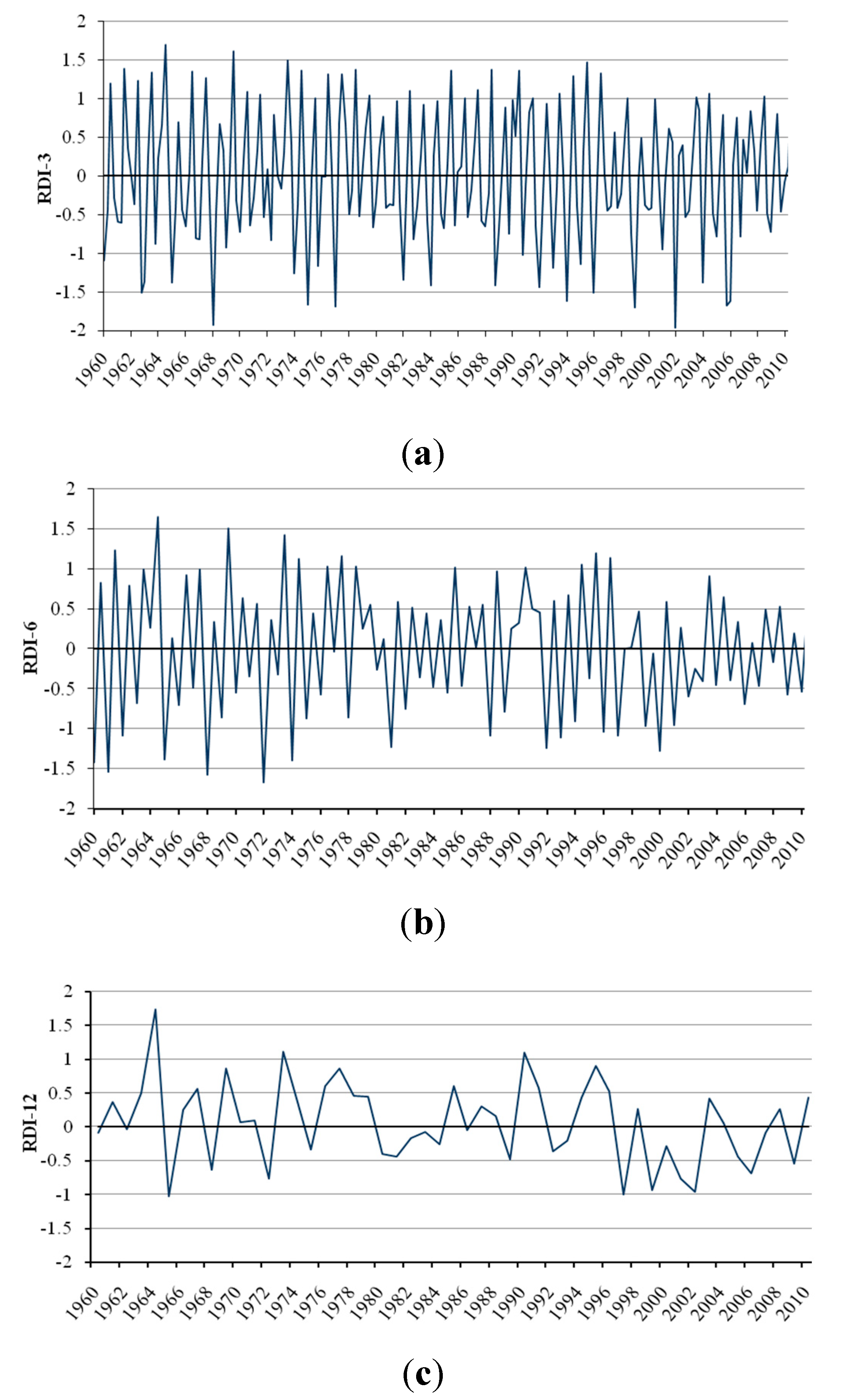
4.2. Spatial Characteristics of Droughts in the BTHMA
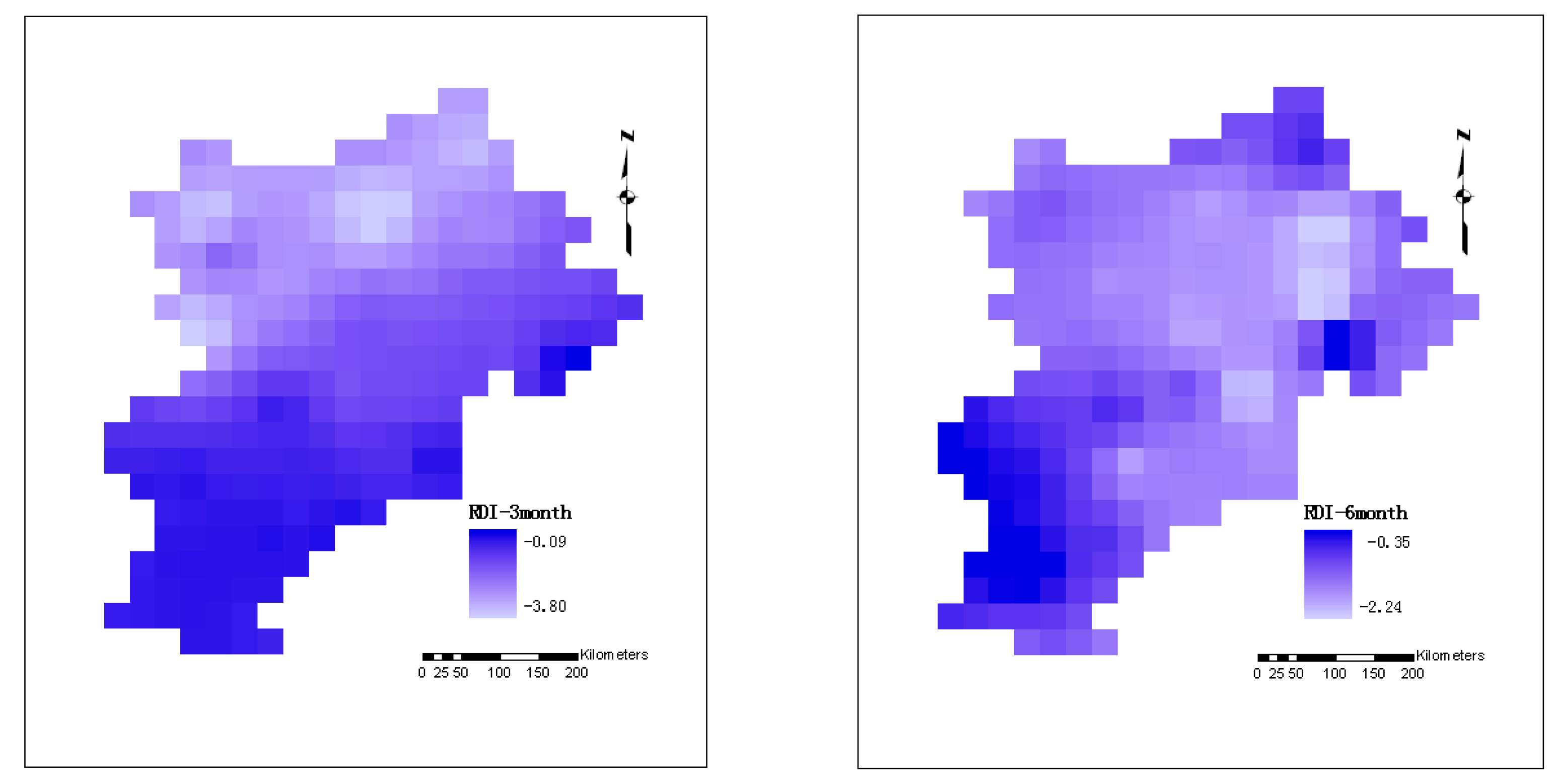
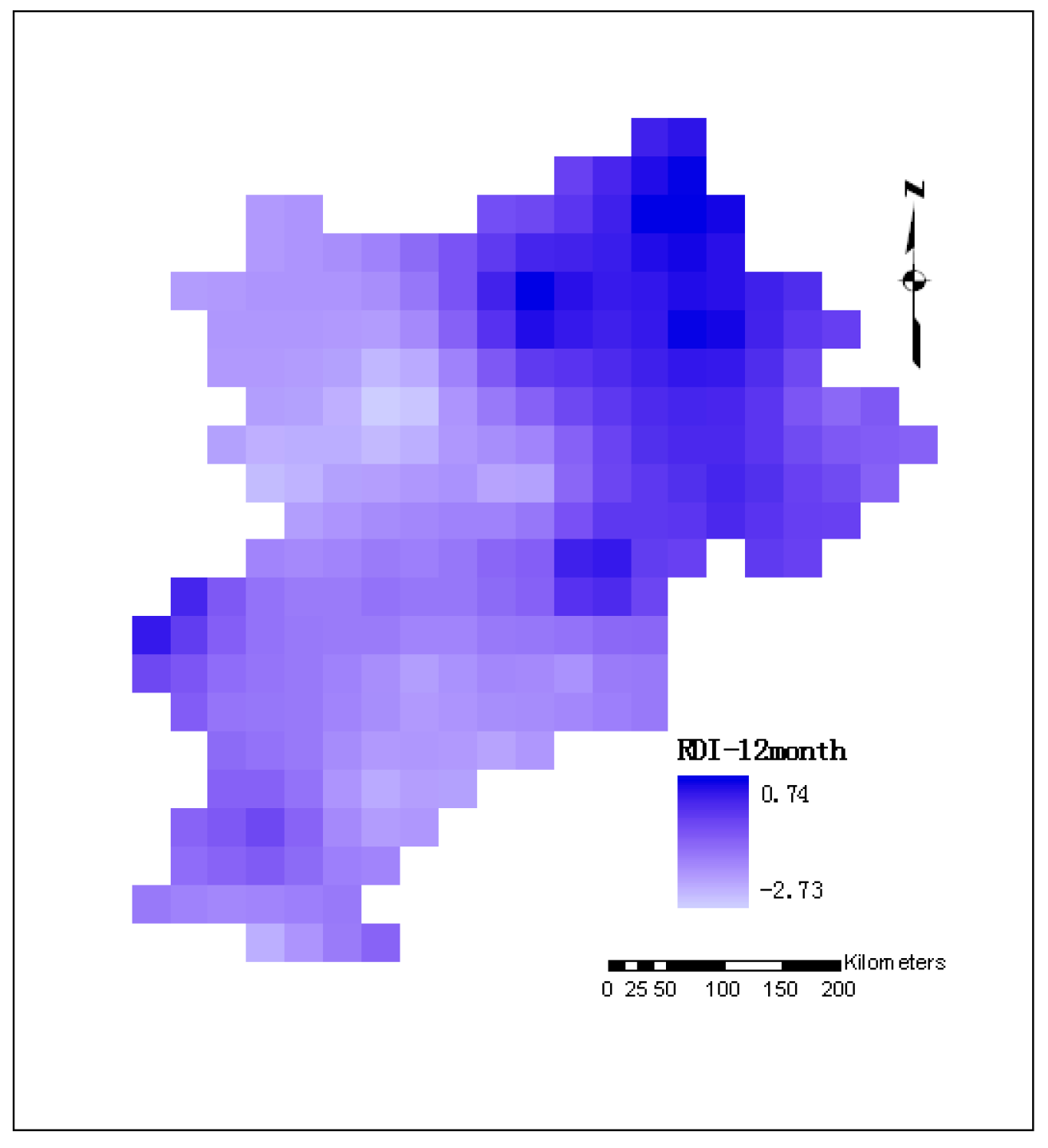


4.3. Drought Severity-Areal Extent-Frequency Curves for the BTHMA

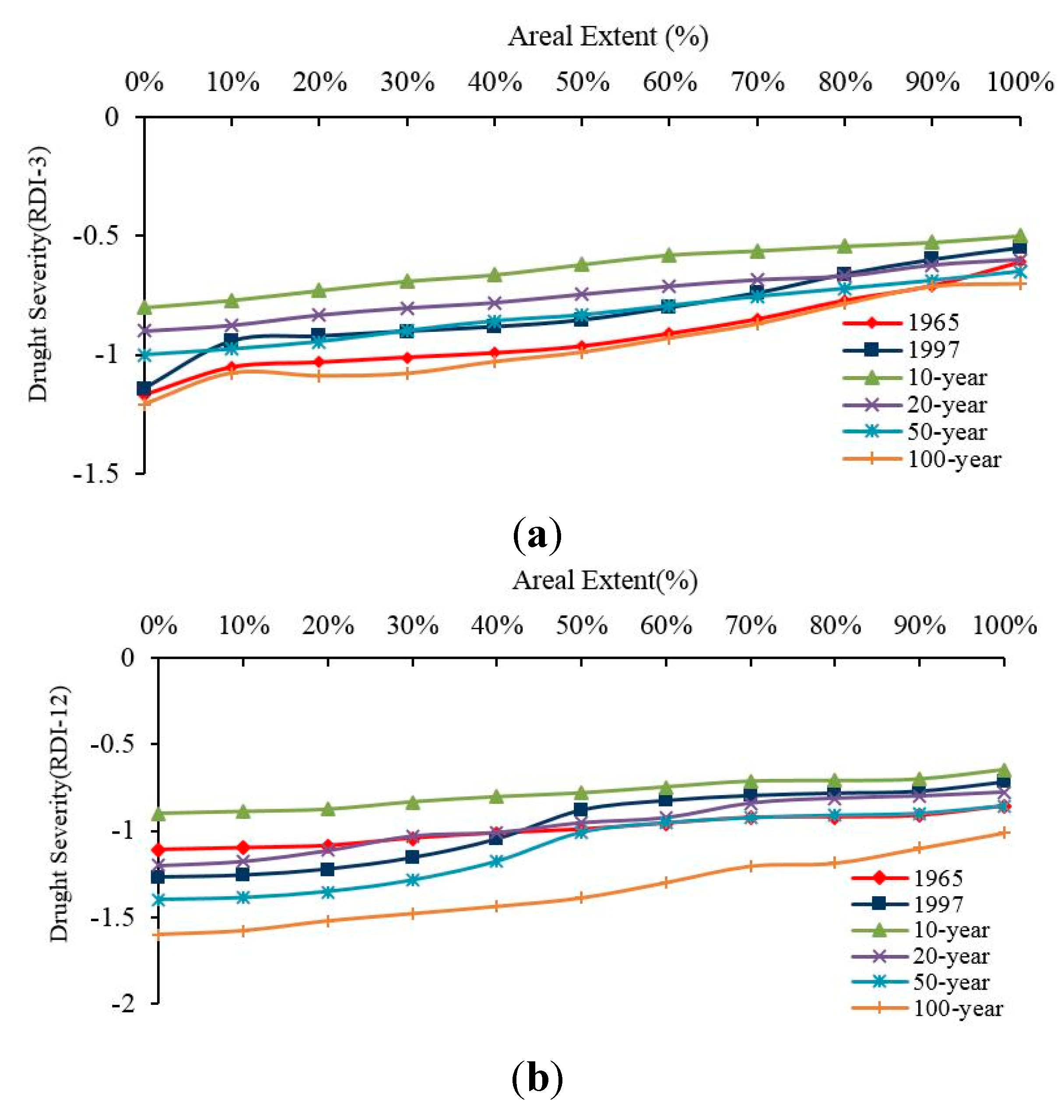
5. Conclusions
Acknowledgements
Author Contributions
Conflict of Interests
References
- Wang, J.S.; Guo, J.Y.; Zhou, Y.W.; Yang, L.F. Progress and prospect on drought indices research. Arid Land Geogr. 2007, 30, 60–65. [Google Scholar]
- Yao, Y.B.; Dong, A.X.; Wang, Y.R.; Zhang, X.Y.; Yang, J.H. Compare research of the regional arid characteristic base on Palmer drought severity index in spring over China. Arid Land Geogr. 2007, 30, 22–29. [Google Scholar]
- Yu, W.J.; Shao, M.Y.; Ren, M.L.; Zhou, H.J.; Jiang, Z.H.; Li, D.L. Analysis on spatial and temporal characteristics drought of Yunnan Province. Acta Ecol. Sin. 2013, 33, 317–324. [Google Scholar] [CrossRef]
- Yoo, J.; Kwon, H.H.; Kim, T.W.; Ahn, J.-H. Drought frequency analysis using cluster analysis and bivariate probability distribution. J. Hydrol. 2012, 420, 102–111. [Google Scholar] [CrossRef]
- Sternberg, T. Regional drought has a global impact. Nature 2011, 472. [Google Scholar] [CrossRef]
- Wilhite, D.A. Drought as a natural hazard: Concepts and definitions. In Drought: A Global Assessment; Wilhite, D.A., Ed.; Routledge: New York, NY, USA, 2000; pp. 3–18. [Google Scholar]
- Paulo, A.A.; Rosa, R.D.; Pereira, L.S. Climate trends and behavior of drought indices based on precipitation and evapotranspiration in Portugal. Nat. Hazards Earth Syst. 2012, 12, 1481–1491. [Google Scholar] [CrossRef]
- Gocic, M.; Trajkovic, S. Spatiotemporal characteristics of drought in Serbia. J. Hydrol. 2014, 510, 110–123. [Google Scholar] [CrossRef]
- Liu, X.Y.; Li, D.L.; Wang, J.S. Spatiotemporal characteristics of drought over China during 1961–2009. J. Desert Res. 2012, 32, 473–483. [Google Scholar]
- Li, S.Y.; Liu, R.H.; Shi, L.K.; Ma, Z.H. Analysis on drought characteristic of Henan in resent 40 years based on meteorological drought composite index. J. Arid Meteorol. 2009, 27, 97–102. [Google Scholar]
- Bao, Y.X.; Meng, C.L.; Shen, S.H.; Qiu, X.F.; Gao, P.; Liu, C. Temporal and spatial patterns of droughts for recent 50 years in Jiangsu based on meteorological drought composite index. Acta Geogr. 2011, 66, 599–608. [Google Scholar]
- Estrela, T.; Menendez, M.; Dimas, M.; Marcuello, C. Sustainable Water Use in Europe. Part 3: Extreme Hydrological Events: Floods and Droughts. Available online: http://www.eea.europa.eu/publications/Environmental_Issues_No_21 (accessed on 9 August 2001).
- Yoo, C.; Kim, S. EOF analysis of surface soil moisture field variability. Adv. Water Resour. 2004, 27, 831–842. [Google Scholar] [CrossRef]
- Clause, B.; Pearsonb, C.P. Regional frequency analysis of annual maximum streamflow drought. J. Hydrol. 1995, 173, 111–130. [Google Scholar] [CrossRef]
- Yuan, G.F.; Wu, L.H. Spatial and temporal analysis on agricultural drought under double cropping system in Beijing-Tianjin-Hebei Plain area. Chin. J. Agrometeorol. 2000, 21, 5–9. [Google Scholar]
- Yan, F.; Wang, Y.J.; Wu, B. Spatial and temporal distributions of drought in Hebei Province over the past 50 years. Geogr. Res. 2010, 39, 423–430. [Google Scholar]
- Mishra, A.K.; Singh, V.P. A review of drought concepts. J. Hydrol. 2010, 354, 202–216. [Google Scholar] [CrossRef]
- Dai, A. Characteristics and trends in various forms of the Palmer Drought Severity Index during 1900–2008. J. Geophys. Res. 2011, 116. [Google Scholar] [CrossRef]
- Van Rooy, M.P. A rainfall anomaly index independent of time and space. Notos 1965, 14, 43–48. [Google Scholar]
- Hollinger, S.E.; Isard, S.A.; Welford, M.R. A new soil moisture drought index for predicting crop yields. In Proceeding of 8th Conference on Applied Climatology, Anaheim, CA, USA, 17–22 January 1993.
- Vasiliades, L.; Loukas, A.; Liberis, N. A water balance derived drought index for Pinios River Basin, Greece. Water Resources Manag. 2011, 25, 1087–1101. [Google Scholar] [CrossRef]
- Palmer, W.C. Keeping track of crop moisture conditions, nationwide: The new crop moisture index. Weatherwise 1968, 21, 156–161. [Google Scholar] [CrossRef]
- Gebrehiwot, T.; van der Veen, A.; Maathuis, B. Spatial and temporal assessment of drought in the Northern highlands of Ethiopia. Int. J. Appl. Earth Obs. Geoinf. 2011, 13, 309–321. [Google Scholar] [CrossRef]
- Vangelis, H.; Tigkas, D.; Tsakiris, G. The effect of PET method on Reconnaissance Drought Index (RDI) calculation. J. Arid Environ. 2013, 88, 130–140. [Google Scholar] [CrossRef]
- Heim, R.R., Jr. A review of twentieth-century drought indices used in the United States. Bull. Am. Meteorol. Soc. 2002, 83, 1149–1165. [Google Scholar] [CrossRef]
- Asadi Zarch, M.A.; Sivakumar, B.; Sharma, A. Droughts in a Warming Climate: A Global Assessment of Standardized Precipitation Index (SPI) and Reconnaissance Drought Index (RDI). Available online: http://www.sciencedirect.com/science/article/pii/S002216941400763X (accessed on 5 October 2014).
- Elagib, N.A.; Elhag, M.M. Major climate indicators of ongoing drought in Sudan. J. Hydrol. 2011, 409, 612–625. [Google Scholar] [CrossRef]
- Farajalla, N.; Ziade, R. Drought Frequency under a Changing Climate in the Eastern Mediterranean: The Beka’a Valley, Lebanon. Available online: http://adsabs.harvard.edu/abs/2010EGUGA.1211653F (accessed on 29 October 2014).
- Khalili, D.; Farnoud, T.; Jamshidi, H.; Kamgar-Haghighi, A.A.; Zand-Parsa, S. Comparability analyses of the SPI and RDI meteorological drought indices in different climatic zones. Water Resour. Manag. 2011, 25, 1737–1757. [Google Scholar] [CrossRef]
- Kirono, D.G.C.; Kent, D.M.; Hennessy, K.J.; Mpelasoka, F. Characteristics of Australian droughts under enhanced greenhouse conditions: Results from 14 global climate models. J. Arid Environ. 2011, 75, 566–575. [Google Scholar] [CrossRef]
- Dimitris, T.; Harris, V.; George, T. Drought and climatic change impact on streamflow in small watersheds. Sci. Total Environ. 2012, 440, 33–41. [Google Scholar] [CrossRef] [PubMed]
- Ke, Z.; Kimball, J.S.; Kim, Y.W.; McDonald, K.C. Changing freeze-thaw seasons in northern high latitudes and associated influences on evapotranspiration. Hydrol. Process. 2011, 25, 4142–4151. [Google Scholar] [CrossRef]
- Naoum, S.; Tsanis, I.K. Temporal and spatial variation of annual rainfall on the island of Crete, Greece. Hydrol. Process. 2003, 17, 1899–1922. [Google Scholar] [CrossRef]
- Bostan, P.A.; Heuvelink, G.B.M.; Akyurek, S.Z. Comparison of regression and kriging techniques for mapping the average annual precipitation of Turkey. Int. J. Appl. Earth Observ. Geoinf. 2012, 19, 115–126. [Google Scholar] [CrossRef]
- AsadiZarch, M.; Malekinezhad, H.; Mobin, M.; Dastorani, M.; Kousari, M. Drought monitoring by Reconnaissance Drought Index (RDI) in Iran. Water Resour. Manag. 2011, 25, 3485–3504. [Google Scholar] [CrossRef]
- Droogers, P.; Allen, R.G. Estimating reference evapotranspiration under inaccurate data conditions. Irrig. Drain. Syst. 2002, 16, 33–45. [Google Scholar] [CrossRef]
- Vangelis, H.; Spiliotis, M.; Tsakiris, G. Drought severity assessment based on bivariate probability analysis. Water Resour. Manag. 2011, 25, 357–371. [Google Scholar] [CrossRef]
- Hargreaves, G.L.; Samani, Z.A. Reference crop evapotranspiration from temperature. Appl. Eng. Agr. 1985, 1, 96–99. [Google Scholar] [CrossRef]
- Thornthwaite, C.W. An approach toward a rational classification of climate. Geogr. Rev. 1948, 38, 55–94. [Google Scholar] [CrossRef]
- Tsakiris, G.; Vangelis, H. Establishing a drought index incorporating evapotranspiration. Eur. Water. 2005, 9, 3–11. [Google Scholar]
- Tsakiris, G.; Nalbantis, I.; Pangalou, D.; Tigkas, D.; Vangelis, H. Drought Meteorological Monitoring Network Design for the Reconnaissance Drought Index (RDI). Available online: http://ressources.ciheam.org/om/pdf/a80/00800419.pdf (accessed on 29 October 2014).
- Abramowitz, M.; Stegun, I.A. Handbook of mathematical functions: With formulas, graphs, and mathematical tables. In Applied Mathematics Series-55; Courier Corporation: Washington, DC, USA, 1965. [Google Scholar]
- Kousari, M.R.; Dastorani, M.T.; Niazi, Y.; Soheili, E.; Hayatzadeh, M.; Chezgi, J. Trend detection of drought in arid and semi-arid regions of Iran based on implementation of reconnaissance drought index (RDI) and application of non-parametrical statistical method. Water Resour. Manag. 2014, 28, 1857–1872. [Google Scholar] [CrossRef]
- Bechini, L.; Ducco, G.; Donatelli, M.; Stein, A. Modelling interpolation and stochastic simulation in space and time of global solar radiation. Agr. Ecosyst. Environ. 2000, 81, 29–42. [Google Scholar] [CrossRef]
- Tsakiris, G.; Tigkas, D.; Vangelis, H.; Pangalou, D. Regional drought identification and assessment. Case study in Crete. In Methods and Tools for Drought Analysis and Management; Springer: Berlin, Germany, 2007; pp. 169–191. [Google Scholar]
- Tigkas, D. Drought characterisation and monitoring in regions of Greece. Eur. Water. 2008, 23–24, 29–39. [Google Scholar]
- Loukas1, A.; Vasiliades, L. Probabilistic analysis of drought spatiotemporal characteristics in Thessaly region, Greece. Natl. Hazards Earth Syst. Sci. 2004, 4, 719–731. [Google Scholar] [CrossRef]
- Gottschalk, L.; Perzyna, G. Low Flow Distribution along a River. Available online: https://www.itia.ntua.gr/hsj/redbooks/213/hysj_213_01_0000.pdf#page=43 (accessed on 29 October 2014).
- Lana, X.; Burgueno, A. Spatial and temporal characterization of annual extreme droughts in Catalonia (Northern Spain). Int. J. Climatol. 1998, 18, 93–110. [Google Scholar] [CrossRef]
- Henriques, A.G.; Santos, M.J.J. Regional drought distribution model. Phys. Chem. Earth B 1999, 24, 19–22. [Google Scholar] [CrossRef]
- Cai, W.; Zhang, Y.; Chen, Q.; Yao, Y. Spatial Patterns and Temporal Variability of Drought in Beijing-Tianjin-Hebei Metropolitan Areas in China. Available online: http://www.hindawi.com/journals/amete/aa/289471/ (accessed on 29 October 2014).
© 2015 by the authors; licensee MDPI, Basel, Switzerland. This article is an open access article distributed under the terms and conditions of the Creative Commons Attribution license (http://creativecommons.org/licenses/by/4.0/).
Share and Cite
Cai, W.; Zhang, Y.; Yao, Y.; Chen, Q. Probabilistic Analysis of Drought Spatiotemporal Characteristics in the Beijing-Tianjin-Hebei Metropolitan Area in China. Atmosphere 2015, 6, 431-450. https://doi.org/10.3390/atmos6040431
Cai W, Zhang Y, Yao Y, Chen Q. Probabilistic Analysis of Drought Spatiotemporal Characteristics in the Beijing-Tianjin-Hebei Metropolitan Area in China. Atmosphere. 2015; 6(4):431-450. https://doi.org/10.3390/atmos6040431
Chicago/Turabian StyleCai, Wanyuan, Yuhu Zhang, Yunjun Yao, and Qiuhua Chen. 2015. "Probabilistic Analysis of Drought Spatiotemporal Characteristics in the Beijing-Tianjin-Hebei Metropolitan Area in China" Atmosphere 6, no. 4: 431-450. https://doi.org/10.3390/atmos6040431






